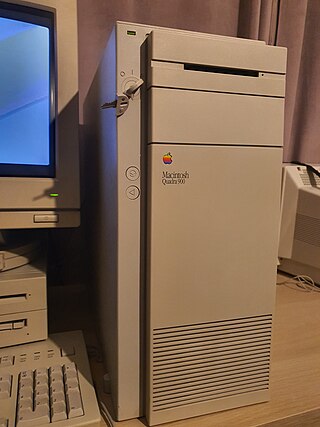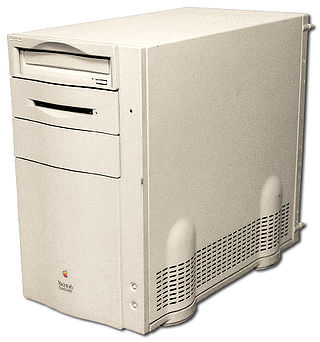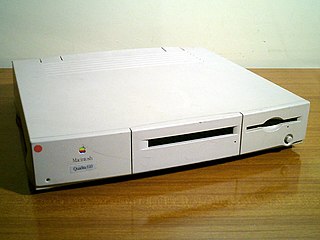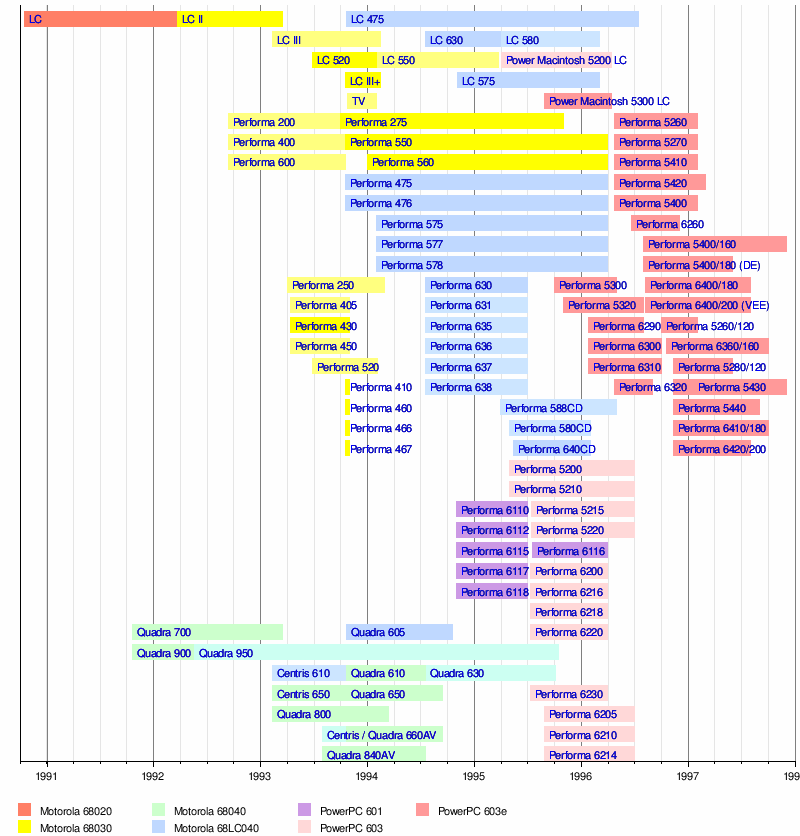
The Apple IIe Card is a compatibility card, which through hardware and software emulation, allows certain Macintosh computers to run software designed for the Apple II series of computers. Released in March 1991 for use with the LC family, Apple targeted the card at its widely dominated educational market to ease the transition from Apple II-based classrooms, with thousands of entrenched educational software titles, to Macintosh-based classrooms.

The Macintosh LC II is a personal computer designed, manufactured, and sold by Apple Computer from March 1992 to March 1993. The LC II is an update to the original Macintosh LC, replacing its Motorola 68020 processor with a 68030 and increasing the onboard memory to 4 MB. The LC II was priced at US$1,699, fully $800 less than the original LC when it was introduced.

The Macintosh Color Classic is a personal computer designed, manufactured and sold by Apple Computer, Inc. from February 1993 to May 1995. It has an all-in-one design, with a small, integrated 10″ Sony Trinitron display at 512 × 384 pixel resolution. The display is capable of supporting up to thousands of colors with a video memory upgrade.

The Macintosh TV is a personal computer with integrated television capabilities released by Apple Computer in 1993. It was Apple's first attempt at computer-television integration. It shares the external appearance of the Macintosh LC 500 series, but in black. The Macintosh TV is essentially a Performa 520 that can switch its built-in 14" Sony Trinitron CRT from being a computer display to a cable-ready television. It is incapable of showing television in a desktop window, although it can capture still frames to PICT files.

The Macintosh Classic II is a personal computer designed and manufactured by Apple Computer, Inc. from October 1991 to September 1993. The system has a compact, appliance design with an integrated 9" monitor, typical of the earliest of the Macintosh range. A carrying handle moulded into the case added a degree of portability at a time when laptops were still relatively uncommon.

The Macintosh IIvx is a personal computer designed, manufactured and sold by Apple Computer from October 1992 to October 1993. It is the last of the Macintosh II family of Macintosh computers. The IIvx was introduced at the same time as the Macintosh IIvi, with both models using the same metal case design as the earlier Performa 600 and Performa 600CD. Like the Performa 600CD, the IIvx could be equipped with an internal double-speed CD-ROM drive.

The Macintosh Quadra 950 is a personal computer designed, manufactured and sold by Apple Computer from March 1992 to October 1995. It replaced the Quadra 900 that was introduced several months earlier, increasing the CPU clock rate of its 68040 CPU from 25 MHz to 33 MHz, and improving the graphics support. The two computers were otherwise identical, including the price. With a Macintosh Processor Upgrade Card installed, this computer is known as the Power Macintosh 950.

The Power Macintosh 6100 is a personal computer designed, manufactured and sold by Apple Computer from March 1994 to March 1996. It is the first computer from Apple to use the new PowerPC processor created by IBM and Motorola. The low-profile ("pizza-box") case was inherited from the Centris/Quadra 610 and 660AV models, and replaced the Macintosh Quadra series that used the Motorola 68040 processor, Apple's previous high-end workstation line.

The Macintosh LC III is a personal computer designed, manufactured, and sold by Apple Computer from February 1993 to February 1994. It replaced the commercially successful Macintosh LC II in Apple's lineup of mid-class computers, and was significantly faster, with MacWorld Magazine benchmarks showing 2x performance in all major categories - CPU, disk, video and maths. It was also significantly less expensive; the LC III with an 80 MB hard disk was priced at US$1,349 at introduction, $700 less than the LC II. The LC III was sold primarily to educational institutions, and a corresponding Performa variant called the Performa 450 was sold to the consumer market.

The Macintosh Quadra 605 is a personal computer designed, manufactured, and sold by Apple Computer from October 1993 to July 1996. The model names reflect a decision made at Apple in 1993 to follow an emerging industry trend of naming product families for their target customers – Quadra for business, LC for education, and Performa for home. Accordingly, the Performa 475 and 476 was sold in department stores and electronics stores such as Circuit City, whereas the Quadra was purchased through an authorized Apple reseller.

The Macintosh Quadra 900 is a personal computer designed, manufactured, and sold by Apple Computer from October 1991 to May 1992. It was introduced alongside the Quadra 700 as the first computers in the Quadra family of Macintosh computers using the Motorola 68040 processor. It is also the first computer from Apple to be housed in an 18.6 inch tall mid-tower form factor, which by 1991 had gained momentum with PC manufacturers as a suitable design for departmental servers.

The Power Macintosh 9500 is a personal computer designed, manufactured and sold by Apple Computer from June 1995 to February 1997. It is powered by a PowerPC 604 processor, a second-generation PowerPC chip which is faster than the PowerPC 601 chip used in the Power Macintosh 8100. The 180MP and 200 MHz models, introduced August 1996, use the enhanced PowerPC 604e processor.

The Power Macintosh 4400 is a personal computer designed, manufactured and sold by Apple Computer, Inc. from November 1996 to February 1998. It differs from prior desktop Macintosh models in that it was built with industry-standard components such as an IDE hard drive and an ATX-like power supply.

The Macintosh Quadra 800 is a personal computer that is a part of Apple Computer's Quadra series of Macintosh computers.

The Power Macintosh 6200 is a series of personal computers designed, manufactured, and sold by Apple Computer from May 1995 to July 1997. The 6200 is the PowerPC-based replacement for the Quadra 630, with the same form factor and price range. In early 1997, the rather different Power Macintosh 6300/160 / Performa 6360 based on the Power Macintosh 6400 was introduced. The whole line was discontinued when the desktop model of the Power Macintosh G3 was released.

The Macintosh Quadra 610, originally sold as the Macintosh Centris 610, is a personal computer designed, manufactured and sold by Apple Computer from February 1993 to July 1994. The Centris 610 was introduced alongside the larger Centris 650 as the replacement for the Macintosh IIsi, and it was intended as the start of the new midrange Centris line of computers. Later in 1993, Apple decided to follow an emerging industry trend of naming product families for their target customers – Quadra for business, LC for education, and Performa for home – and folded the Centris 610 into the Quadra family.

The Macintosh Quadra 650, originally sold as the Macintosh Centris 650, is a personal computer designed, manufactured and sold by Apple Computer from February 1993 to September 1994. The Centris 650 was introduced alongside the smaller Centris 610 as the replacement for the Macintosh IIci and Quadra 700, and it was intended as the start of the new midrange Centris line of computers. Later in 1993, Apple decided to follow an emerging industry trend of naming product families for their target customers – Quadra for business, LC for education, and Performa for home – and folded the Centris 650 into the Quadra family.
The Macintosh LC 500 series is a series of personal computers that were a part of Apple Computer's Macintosh LC family of Macintosh computers, designed as a successor to the compact Macintosh family of computers for the mid-1990s mainstream education-market. The all-in-one desktop case is similar to the then recently introduced Macintosh Color Classic, but the LC 500 series is considerably larger and heavier due to its larger screen and a bulging midsection to house the larger electronics, including a 14" CRT display, CD-ROM drive, and stereo speakers.

The Power Macintosh 5260 is a personal computer designed, manufactured and sold by Apple Computer, Inc. from April 1996 to March 1997. It is a replacement for the Power Macintosh 5200 LC, retaining its all-in-one form factor while replacing its PowerPC 603 CPU with the newer and faster PowerPC 603e, and dropping the "LC" brand. As was standard practice at the time for Apple, the 5260 was re-branded as a number of Performa models and sold to consumer markets, while the 5260 itself was primarily sold to the North American education market as a Power Macintosh.

The Power Macintosh 5500 is a personal computer designed, manufactured, and sold by Apple Computer from February 1997 to March 1998. Like the Power Macintosh 5260 and 5400 that preceded it, the 5500 is an all-in-one design, built around a PowerPC 603ev processor operating at 225, 250 or 275 megahertz (MHz).





















